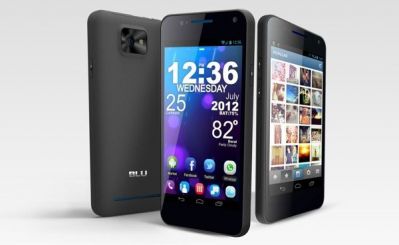OLED displays use organic materials that emit light when electricity is applied. OLEDs enable emissive, bright, thin, flexible and efficient displays. OLEDs are set to replace LCDs in all display applications - from small displays to large TV sets.
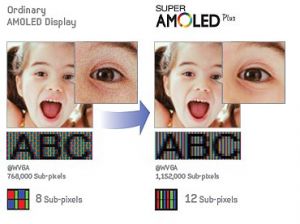
Samsung's Super AMOLED Plus displays were an 2011-2012 upgrade to the company's Super AMOLED displays. Super AMOLED Plus display used a regular (RGB strip) sub pixel scheme as opposed to the Pentile Matrix used in 'regular' Super AMOLED displays. Only a handful of devices, shipped in 2011 and 2012 by Samsung and other companies did use Super AMOLED Plus displays. Samsung seems to have stopped using this brand and are now focused on Pentile scheme for all of its AMOLED panels.
Super AMOLED Plus devices
Super AMOLED Plus was announced in CES 2011, together with the first phone to sport these displays - the Infuse 4G. The display was a 4.5" one. Samsung's Galaxy S2 also had a Super AMOLED plus display (4.3" WVGA)
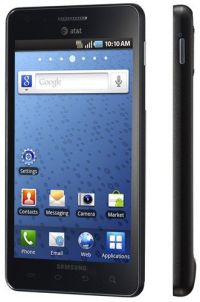
Samsung also adopted a Super AMOLED Plus display in their first OLED Tablet, the Galaxy Tab 7.7 (7.7" 1280x800 display).
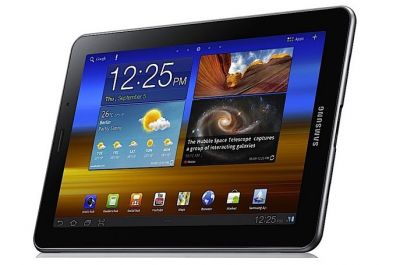
Is Super AMOLED Plus dead?
The last device to actually sport a Super AMOLED Plus display was BLU's Vivo 4.3, a Dual-SIM smartphone introduced in 2012. Since then Samsung did not release any new device with a Super AMOLED Plus display - all of Samsung's newest phones and tablets use a 'regular' Super AMOLED display (with a Pentile Matrix).

Further reading
- Introduction to OLEDs
- Samsung's OLED displays
- Super AMOLED Technology explained
- Pentile Technology explained
- OLED mobile phones
- The OLED Handbook, our very own comprehensive guide to OLEDs
Samsung launches three new AMOLED phones, the A33, A53 and the A73
Samsung announced three new Samsung Galaxy phones, in its popular mid-range A-series. First up is the Galaxy A33 which features a 6.4" 90Hz 1080x2400 Super AMOLED display, and the second is the Galaxy A53 which features a larger 6.5" 120Hz 1080x2400 Super AMOLED display.
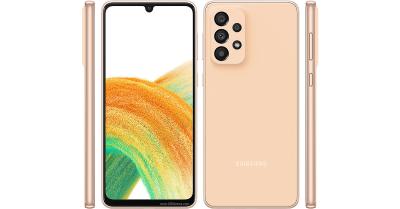
Most interesting is the Galaxy A73,which sports a 6.7" 120Hz 1080x2400 Super AMOLED+. It is not clear what Samsung refers to as a Super AMOLED+, it could be a non-pentile display like the old Super AMOLED Plus displays.
Samsung launches several new AMOLED devices, including the Note 20 and the Galaxy Z Fold 2
Samsung announced several new OLED devices yesterday. We'll start with the new Galaxy Note 20 which sports a 6.7-inch 1080x2400 HDR10+ Super AMOLED Plus display (which could mean this is an RGB display, not a Pentile one). The Galaxy Note 20 Ultra has a larger 6.9-inch 1440x3088 Dynamic AMOLED. The display supports a refresh rate of 120Hz at Full-HD resolution and 60Hz at QHD. According to the Elec in Korea, the Note 20 Ultra display has an LTPO backplane (which Samsung calls HOP).
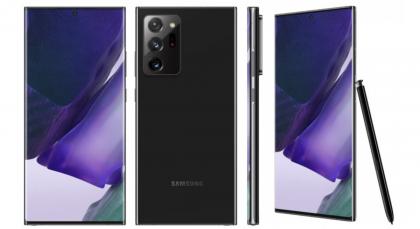
Next up is the company's 2nd generation Galaxy Z Fold 2 that is an update to the original fold with a larger internal foldable display at 7.6" 1768x2208 HDR10+ 120Hz Dynamic AMOLED and also a larger 6.23" 816x2260 Super AMOLED cover display. The Fold 2 also improves the hinge design and sports an ultra-thin-glass cover (like the Galaxy Z Flip).
BLU's Vivo 4.3 Dual-SIM Super AMOLED Plus smartphone now shipping
BLU's Vivo 4.3 is now shipping unlocked in the US for $269. The Vivo 4.3 is a Dual-SIM smartphone (Android v4.0) with a 4.3" Super AMOLED Plus display, a 1Ghz dual-core CPU, 4GB memory (and a microSD slot) and a 8mp camera.
The Galaxy Note 2 uses a non-pentile OLED display at 267 PPI
When Samsung announced the Galaxy Note 2, with its 5.5" 1280x720 HD Super AMOLED display, I assumed it was a Pentile display. But it seems that the Note 2 actually uses an RGB matrix in a unique arrangement (see the photo below). Samsung calls this new matrix S-Stripe. This is rather confusing on several accounts - mostly because up till now Samsung used the brand Super AMOLED Plus for non-pentile OLEDs.
![]()
Just a few weeks ago we explained that Pentile OLED displays enable higher lifetime, and we were told that for an RGB OLED with over 230 PPI, lifetime becomes too low for Samsung and they choose Pentile in those displays. But the Note II has a PPI of 267 - the highest PPI non-Pentile OLED. This means it has a lower lifetime compared to a Pentile display (but the advantage is that there's no visible Pentile pattern of course).
Nouvoyance explains why PenTile OLEDs last longer
A few months ago Samsung said that the new Galaxy S3 has a Pentile display (a 4.8" 1280x720 HD Super AMOLED one to be exact) because PenTile increased the lifetime of OLED panels. I have discussed this with Joel Pollack, an Executive VP at Nouvoyance (Samsung's company that developed the PenTile matrix scheme), and he explains this claim further.
An OLED display is made from colored (RGB) sub pixels. A blue OLED has the lowest luminous efficiency (lower then red and green) and so needs to be driven at higher current - which means a lower lifetime.
DisplayMate presents a Galaxy S range shootout - sees rapid performance improvements
Raymond Soneira, our friend and display guru from DisplayMate have posted a very interesting and detailed comparison of the OLED displays in the Galaxy S, SII and SIII phones. He says that while all three OLED panels performed very well, there has been a rapid and significant improvement in OLED performance (especially power efficiency) in just 2 years.
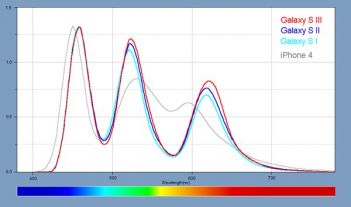
Raymond says that high-end LCDs are brighter and more power efficient than OLEDs for text and web applications. OLEDs are better for photos and videos. He also says that while the performance is excellent, it's been compromised by Samsung's implementation choices - especially the low brightness due to power constraints (although low reflectence on those devices mean that high brightness is not critical in most situations).
Engadget reviews the S3: the display is great, better than older AMOLEDs
Engadget posted a review of the Galaxy S3, and while they think the phone is excellent, they're not sure if the S3 is the best Android phone on the market, with the main competitor being the HTC One X. They love the 1280x720 4.8" Super AMOLED HD display, and say that there are real visual improvements over the Galaxy Nexus. The colors aren't over-saturated and there's no unnatural blue-ish tint.
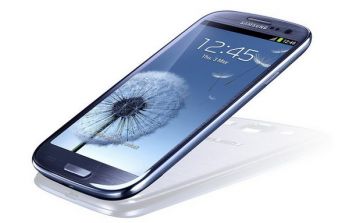
Regarding the controversial PenTile technology, Engadget says that it isn't so visible because the screen is large and you tend to hold it from a little bit further than in smaller phones. But it still makes text a bit fuzzy, and so if you like reading on your book, maybe it's better to choose a non-Pentile phone (I personally think it's better to use a dedicated e-paper e-reader if you actually want to read).
Samsung producing sample Super AMOLED Plus HD displays, used in Tizen developer phone?
Just a few minutes ago we posted about Samsung's claim that they used Pentile in the Galaxy S3 because it lasts longer. There are some reports however that Samsung already managed to produce Super AMOLED HD Plus 4.8" display. In fact it is said that they are using this display in a Tizen (open source OS) development model that they handed out to some developers.
It may be that Samsung cannot yet mass produce such displays, and so they couldn't use it in the S3. Anyway we'll probably know more soon...
Samsung - we keep using PenTile AMOLED displays because they last longer
Update: We discussed this with Nuovoyance's VP, he explains better why PenTile displyas lasts longer...
Some people really dislike Pentile displays, but Samsung keep producing AMOLED with PenTile - even in their flagship devices such as the new Galaxy S3 (which sports a 4.8" 1280x720 HD Super AMOLED). Today we hear that Samsung says that one of the major advantages of PenTile AMOLED displays is increased lifetime.
In PenTile displays, there are twice as many green subpixels as there are blue suxpixels. Blue OLEDs feature the lowest lifetime, and so Pentile displays "tend" to last longer, according to Samsung. In any case, as the resolution gets higher, it's getting harder to actually notice the "fuzziness" caused by the Pentile Matrix...
Samsung to unveil the next galaxy on May 3rd
Samsung announced they will unveil the new Galaxy device on May 3rd in London. Here's the invitation flyer:

Samsung wouldn't reveal any information of course. Hopefully the new Galaxy (the S3?) will sport a new AMOLED display. Most rumors suggest this will be a 4.5" Super AMOLED Plus HD display (i.e. without pentile) - which means that Samsung's production precision has improved.
Pagination
- Page 1
- Next page


